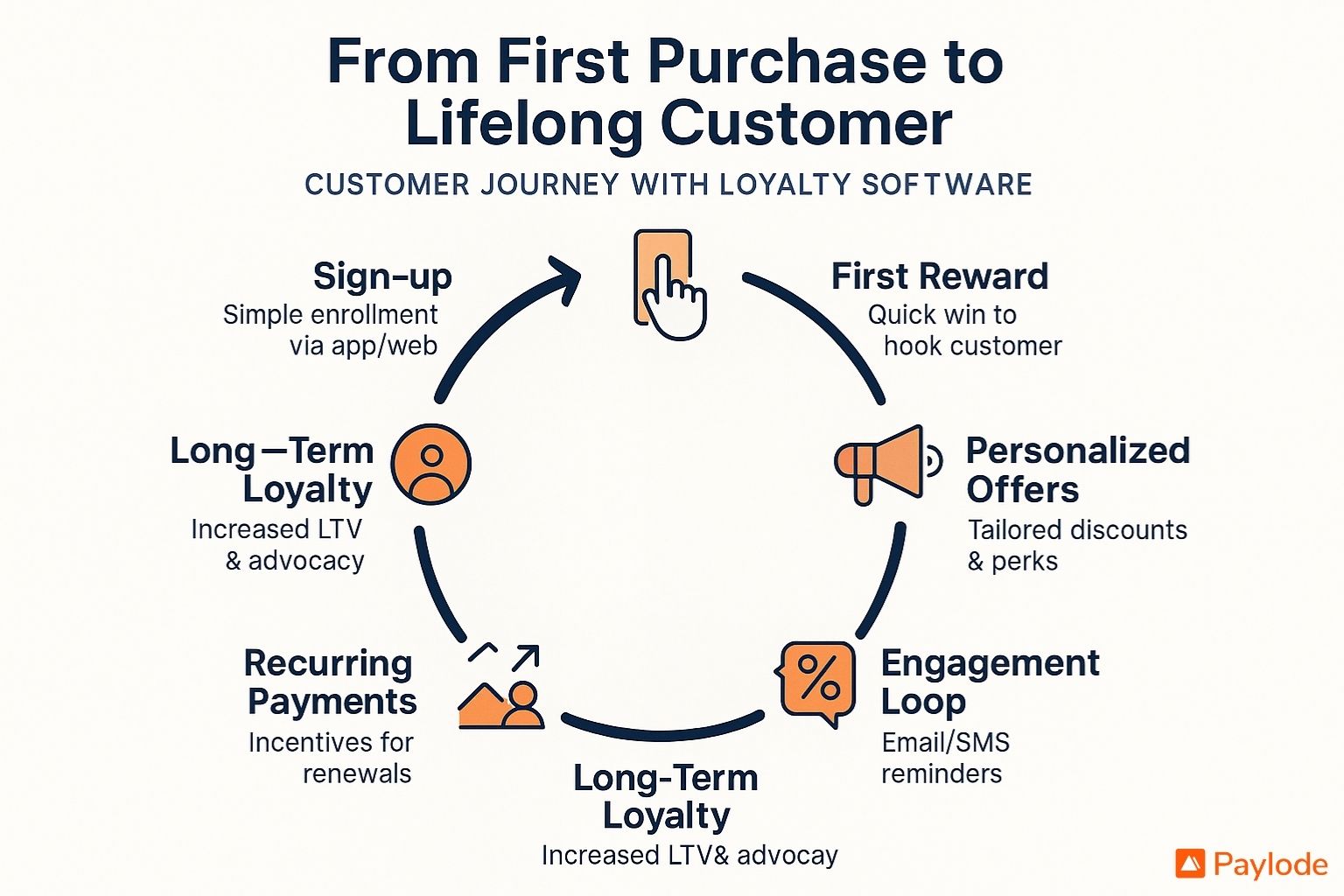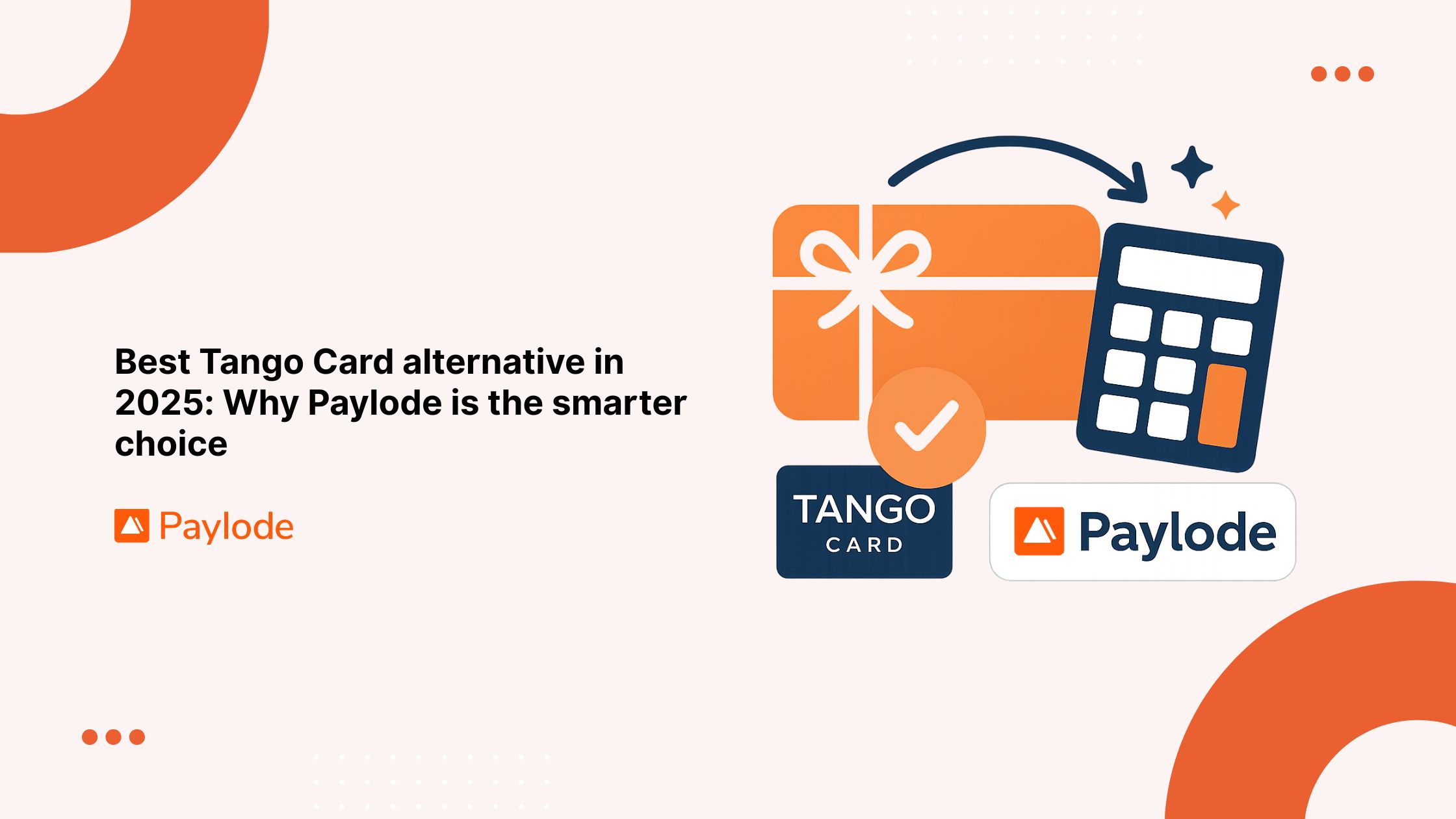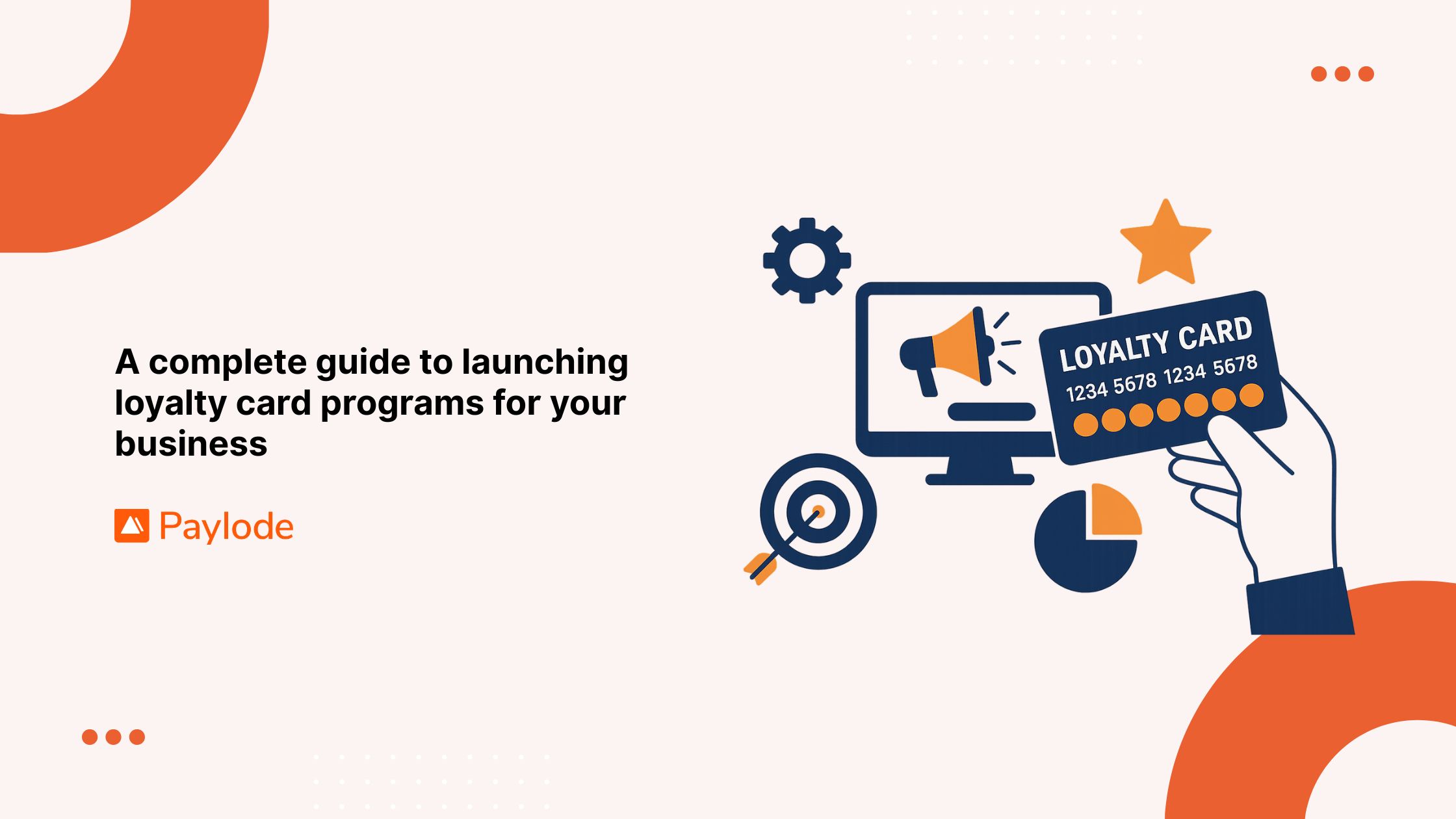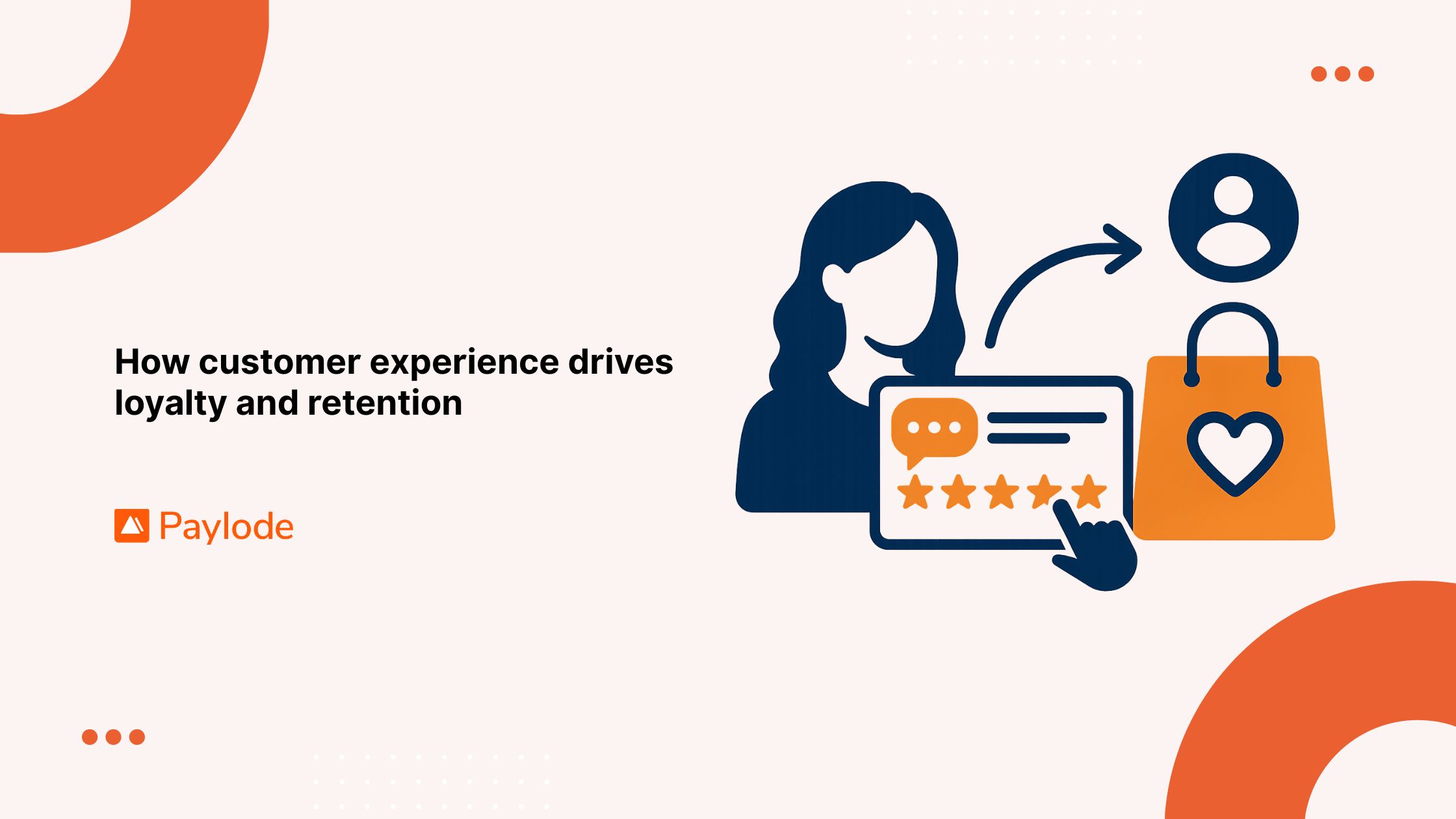In today’s competitive landscape, attracting new customers often takes center stage. Yet, the real driver of sustainable business growth is customer retention. Studies show that acquiring a new customer can cost up to 5 – 7 times more than retaining an existing one. That’s why leading companies across industries—whether it’s telecom, financial services, real estate, or digital health—are turning to customer loyalty software as a proven solution to keep customers engaged, satisfied, and loyal.
Unlike traditional loyalty programs that simply reward purchases, modern customer loyalty software goes deeper. It uses data, automation, and personalization to strengthen customer relationships at every touchpoint. Think about an ISP reducing churn with subscription perks, or a residential real estate firm improving tenant renewals by offering meaningful rewards like resident perks. These aren’t just discounts; they’re strategies that improve customer lifetime value (LTV) and retention.
In this complete guide, we’ll explore:
- The benefits of customer loyalty software for businesses of all sizes
- How it helps boost retention and revenue
- The difference between software-driven loyalty platforms and basic rewards programs
- The must-have features to look for in a loyalty solution
- How small, mid-sized, and enterprise businesses can all adopt customer loyalty software
- Practical steps to choosing the right solution
- Future trends shaping the space in 2025 and beyond
- 10 actionable ways customer loyalty software improves customer experience (CX)
- Real-world case studies and ROI examples from industries like telecom, financial services, and digital health
By the end of this guide, you’ll know exactly how customer loyalty software can transform retention into one of your business’s biggest growth engines.
Top benefits of customer loyalty software for growing businesses
Customer loyalty software provides measurable benefits that go far beyond giving discounts. For growing businesses—especially those with recurring revenue models—it becomes a retention powerhouse.
1. Reduced churn and higher retention
- In the telecom and ISP industries, churn is one of the biggest challenges. Loyalty software helps reduce churn by offering perks tied to digital adoption, autopay, or bundled services.
- Example: An ISP offering a perk for switching to paperless billing not only reduces costs but also locks in customer commitment. Switch to paperless →
2. Higher customer lifetime value (LTV)
- When customers are rewarded for recurring payments, renewals, or cross-service usage, their average lifetime value increases.
- In financial services, loyalty platforms encourage customers to adopt multiple products like credit cards, insurance, or investment accounts—raising LTV.
3. Increased engagement and satisfaction
- Unlike static reward programs, customer loyalty software creates habitual engagement through mobile apps, email, and SMS.
- For residential real estate, offering resident perks such as gym memberships, local deals, or discounts on utilities can significantly boost tenant satisfaction.
4. Cost efficiency compared to acquisition
- According to Bain & Co., a 5% increase in customer retention can drive up to 25–95% profit growth.
- Retaining existing customers is cheaper, faster, and yields better margins than chasing new ones.
5. Competitive advantage
- In crowded markets, customer loyalty software differentiates your brand. Businesses that integrate loyalty seamlessly into customer journeys create stickier experiences that are harder to replace.
In short: Loyalty software isn’t just a “nice-to-have.” It’s a growth strategy that powers revenue, efficiency, and long-term success.
How Customer Loyalty Software Boosts Retention and Revenue
The biggest reason businesses invest in customer loyalty software is its direct impact on retention and revenue. When customers feel valued, they are more likely to stay longer, spend more, and even recommend your brand to others.
1. Encourages repeat purchases and renewals
Loyalty software makes it easy to reward customers for behaviors that matter—renewing a subscription, paying bills on time, or choosing an upgrade. For example, in digital health platforms, giving perks for subscription renewals not only boosts engagement but also ensures steady recurring revenue.
2. Builds emotional loyalty
Traditional rewards programs often focus on transactions only—buy something, get a point. But software-driven loyalty platforms add a layer of emotional connection by recognizing milestones, sending personalized perks, and celebrating customer achievements. This type of engagement is what drives long-term loyalty.
3. Increases cross-sell and upsell opportunities
In industries like financial services, customer loyalty software creates smart triggers to promote complementary products. A bank could reward customers for signing up for both a credit card and an investment account, raising customer lifetime value without feeling pushy.
4. Improves digital adoption and reduces costs
Loyalty software also helps businesses encourage digital-first behaviors that reduce operational expenses. For instance, many ISPs use it to promote paperless billing and autopay enrollment — cutting down paper and service costs while boosting customer convenience. Switch to paperless →
5. Strengthens retention through insights
Most platforms come with real-time dashboards that track customer activity. Businesses can quickly see which perks drive the most engagement and which customers are at risk of leaving. Acting on these insights helps prevent churn before it happens.
The bottom line: Customer loyalty software works as a revenue multiplier. By reducing churn, improving engagement, and creating upsell opportunities, it helps businesses grow without spending heavily on new customer acquisition.
Customer Loyalty Software vs. Rewards Programs: What’s the Difference?
Many businesses confuse customer loyalty software with a simple rewards program. While they share the same goal—keeping customers engaged—their approach and effectiveness are very different.
Traditional Rewards Programs
Rewards programs usually focus on transactions only. A common example is the “buy 10 coffees, get 1 free” punch card. These programs are easy to run but offer very little personalization or data insights. Customers may take advantage of the rewards without forming a deeper connection with the brand.
Customer Loyalty Software
In contrast, customer loyalty software is a technology platform designed to personalize, automate, and track engagement. Instead of just giving discounts, it can:
- Send rewards based on customer preferences.
- Encourage behaviors like on-time bill payments or subscription renewals.
- Track engagement across mobile apps, email, and SMS.
- Provide real-time analytics to understand which perks are working best.
For example, in residential real estate, a property manager could use loyalty software to offer perks like local restaurant vouchers or fitness discounts. This goes far beyond a one-size-fits-all discount, making residents feel valued and more likely to renew their lease.
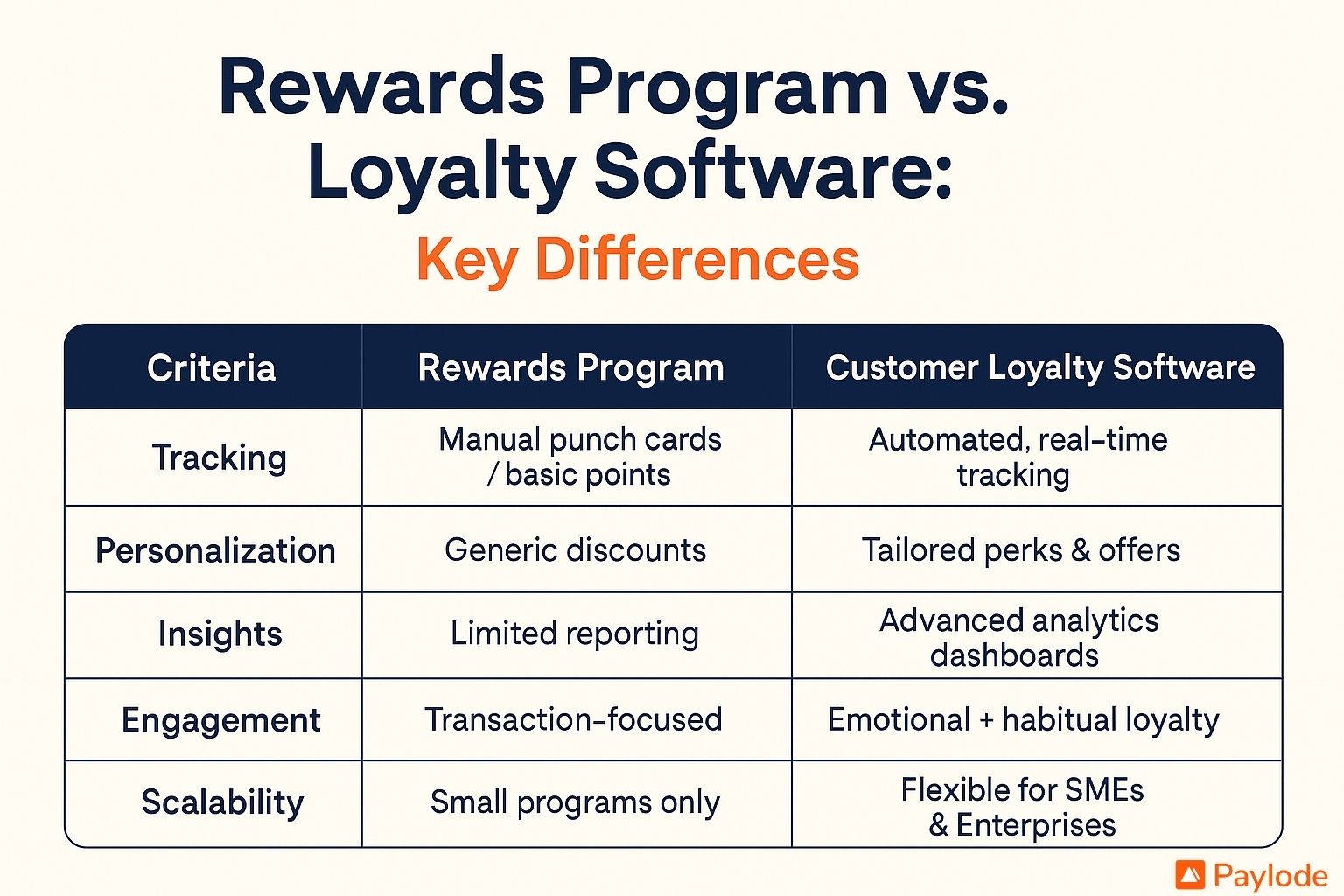
Key Difference: Data & Personalization
The most important distinction is that rewards programs are manual and generic, while loyalty software is automated and data-driven. With real-time insights, businesses can create perks that feel relevant, not random. This is what helps turn a satisfied customer into a loyal advocate.
Here’s a quick comparison:
If you’d like to see how modern loyalty software works in practice, explore Paylode’s loyalty solutions to understand the difference.
Best Features to Look for in Customer Loyalty Software
When choosing customer loyalty software, the right features can make all the difference between a program that customers love and one they ignore. Below are the essential features every business should look for.
1. Automation and Integrations
Good loyalty software should reduce manual work. Automation allows rewards to be triggered instantly when a customer completes an action—like paying a bill, making a repeat purchase, or referring a friend. Seamless integrations with your CRM, billing system, and apps ensure the experience is smooth for both your team and your customers.
2. Personalized Rewards and Perks
One-size-fits-all discounts are outdated. Customers want rewards that feel relevant to them. Modern software allows you to design personalized perks based on customer preferences, location, or behavior. For instance, an ISP could reward customers who switch to autopay with free streaming credits, making the perk useful and engaging.
3. Real-Time Analytics
Without data, you’re just guessing. Real-time analytics helps you track which perks are driving engagement, reducing churn, or increasing renewals. This visibility makes it easier to adjust your program quickly and focus on what works.
4. Multi-Channel Engagement
Customers interact with brands across many touchpoints—mobile apps, emails, SMS, and web portals. Your loyalty platform should support all of them. This ensures consistent communication and makes rewards more visible, which boosts participation.
5. Scalability
Whether you’re a small business or a large enterprise, your loyalty platform should be able to scale with you. Look for software that can manage thousands of users, multiple integrations, and growing datasets without losing performance.
6. Easy-to-Use Dashboard
Your team should not need advanced technical skills to run loyalty programs. A clear dashboard with drag-and-drop features, campaign management tools, and reporting makes it simple to manage everything in one place.
Example: Real Estate Loyalty Perks
Consider a residential real estate company. By offering rewards like moving discounts, local gym memberships, or partner restaurant vouchers, loyalty software helps increase tenant satisfaction. This creates long-term relationships, leading to more lease renewals and fewer vacancies.
To see how these features can be applied in real-world industries, visit Paylode’s customer loyalty platform.
How to Choose the Right Customer Loyalty Software for Your Business
Selecting the right customer loyalty software can feel overwhelming with so many options in the market. The key is to focus on your business goals, customer needs, and long-term growth. Here are the most important steps to follow:
1. Define Your Goals
Start by asking: What do we want to achieve?
- Do you want to reduce churn?
- Increase customer lifetime value (LTV)?
- Drive upselling or cross-selling?
Clear goals will help you choose a platform that is designed to deliver on those outcomes.
2. Check Integration Capabilities
Your loyalty software should not work in isolation. Look for a platform that connects smoothly with your CRM, billing system, payment processors, and customer apps. This ensures that rewards are applied instantly and customer data flows seamlessly across all systems.
3. Evaluate Scalability
A program that works for 500 customers may fail at 50,000. Ensure the software is built to scale as your customer base and engagement grow. Enterprise-ready platforms allow you to manage more users, advanced features, and multiple integrations without slowing down.
4. Must-Have Analytics Dashboard
Data is the backbone of a strong loyalty program. An easy-to-use analytics dashboard lets you track key metrics such as redemption rates, churn reduction, and renewal growth. Without these insights, it’s hard to prove ROI or make program improvements.
5. Prioritize Personalization Features
Customers don’t want generic discounts. Choose a platform that allows you to personalize perks based on customer preferences, behaviors, or milestones. For example, a financial services provider could reward savings milestones with lower fees or bonus interest rates.
Quick Checklist: What to Look for in a Loyalty Platform
Learn more about how Paylode helps businesses of all sizes choose and implement the right loyalty platform by visiting the Paylode solutions page.
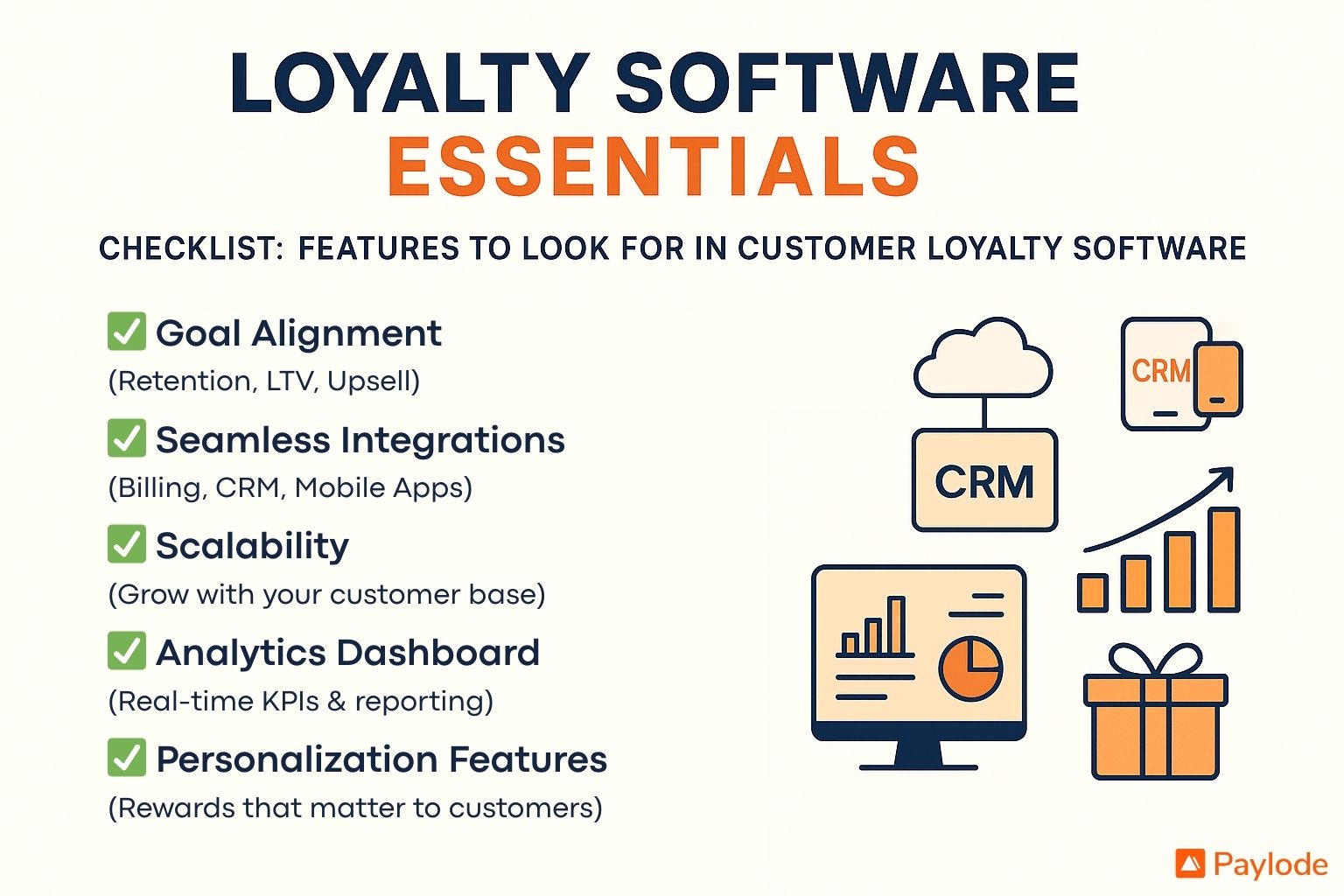
Future of Customer Loyalty Software: Trends to Watch in 2025
The way businesses approach customer retention is evolving quickly. By 2025, customer loyalty software will no longer be just about points and discounts—it will focus on personalization, digital convenience, and creating real value for customers. Here are the top trends to watch:
1. AI-Driven Personalization
Artificial Intelligence is transforming how brands interact with customers. Loyalty platforms will use AI to analyze customer behavior in real time and recommend the right reward, message, or offer at the right moment. For instance, an ISP could send an instant discount to a customer at risk of churn, keeping them engaged.
2. Subscription-Based Rewards
With the rise of subscription models in industries like digital health, OTT, and even residential real estate, loyalty software will integrate subscription perks. Think free add-ons, premium upgrades, or reduced renewal rates as loyalty benefits. This encourages recurring payments and long-term retention.
3. Gamification and Engagement Loops
Gamified loyalty is gaining traction—points, badges, challenges, and tiered milestones make customers feel more involved. By 2025, more platforms will add interactive features that create habitual engagement, similar to how fitness apps reward streaks or progress.
4. Seamless Multi-Channel Experience
Customers no longer interact with brands through just one channel. Future loyalty software will ensure rewards and communications are consistent across mobile apps, websites, SMS, and email. This creates a frictionless experience where customers can engage with the program anytime, anywhere.
5. Sustainability-Linked Rewards
Eco-conscious customers are pushing businesses to integrate sustainability into loyalty programs. Instead of only offering discounts, brands may provide carbon credits, eco-points, or donations to green initiatives as loyalty perks. This aligns loyalty with values that matter to today’s consumers.
6. Real-Time Data and Predictive Analytics
Beyond reporting past behavior, next-gen loyalty platforms will predict churn, forecast lifetime value (LTV), and recommend strategies to maximize retention. Businesses that leverage predictive analytics will stay ahead in creating smarter loyalty strategies.
What This Means for Businesses
The future of customer loyalty software is about creating stronger emotional connections, not just transactional relationships. Companies that embrace personalization, gamification, and sustainability will stand out in competitive markets. Those who rely only on traditional discounts may find themselves losing ground.
To prepare for these changes, explore Paylode’s approach to modern loyalty solutions and see how you can future-proof your retention strategy.
10 Ways Customer Loyalty Software Improves Customer Experience (CX)
Customer loyalty software is not only about retention and revenue—it also plays a big role in shaping customer experience (CX). When customers feel valued and engaged, they are more likely to stay loyal and advocate for your brand. Here are 10 ways loyalty platforms make CX better:
1. Personalized Interactions
Instead of sending generic discounts, loyalty platforms tailor perks to each customer’s preferences—like offering movie vouchers to entertainment lovers or travel credits to frequent flyers. This level of personalization makes customers feel understood.
2. Seamless Digital Onboarding
From day one, customers can join a loyalty program through a mobile app, website, or email link. This frictionless onboarding experience increases participation and sets a positive tone for the relationship.
3. Faster Rewards Redemption
Nothing frustrates customers more than complex redemption rules. Modern loyalty software simplifies this by enabling one-click reward usage across channels, improving satisfaction and convenience.
4. Omnichannel Engagement
Loyalty platforms integrate with mobile apps, SMS, email, and in-store touchpoints, giving customers a consistent experience wherever they interact with the brand.
5. Building Emotional Connection
By rewarding behaviors beyond transactions—such as social sharing, referrals, or eco-friendly choices—brands foster emotional loyalty, making customers feel like part of a community rather than just buyers.
6. Encouraging Repeat Usage
Simple nudges like “earn double points this week” or “unlock free delivery on your next 3 purchases” encourage repeat usage. This gamified engagement not only boosts retention but also makes CX more enjoyable.
7. Real-Time Support Integration
Some loyalty platforms link rewards with support interactions. For example, if a customer faces a billing issue, resolving it quickly could also trigger a loyalty perk, turning a negative moment into a positive one.
8. Transparency and Trust
With features like real-time balance tracking and clear reward rules, loyalty software eliminates confusion and builds trust. Customers know exactly what they’re earning and how to use it.
9. Community Engagement
Loyalty software can include forums, referral rewards, or shared perks, creating a sense of belonging. This community-driven approach strengthens CX by connecting customers with both the brand and each other.
10. Feedback and Continuous Improvement
Modern platforms collect customer data and feedback, helping businesses refine offers and improve service quality. This creates a loop where customers see their input leading to better experiences.
Why It Matters
Customer loyalty software is no longer just a retention tool—it’s a CX engine. By creating personalized, seamless, and emotionally engaging experiences, businesses increase satisfaction, reduce churn, and raise lifetime value (LTV).
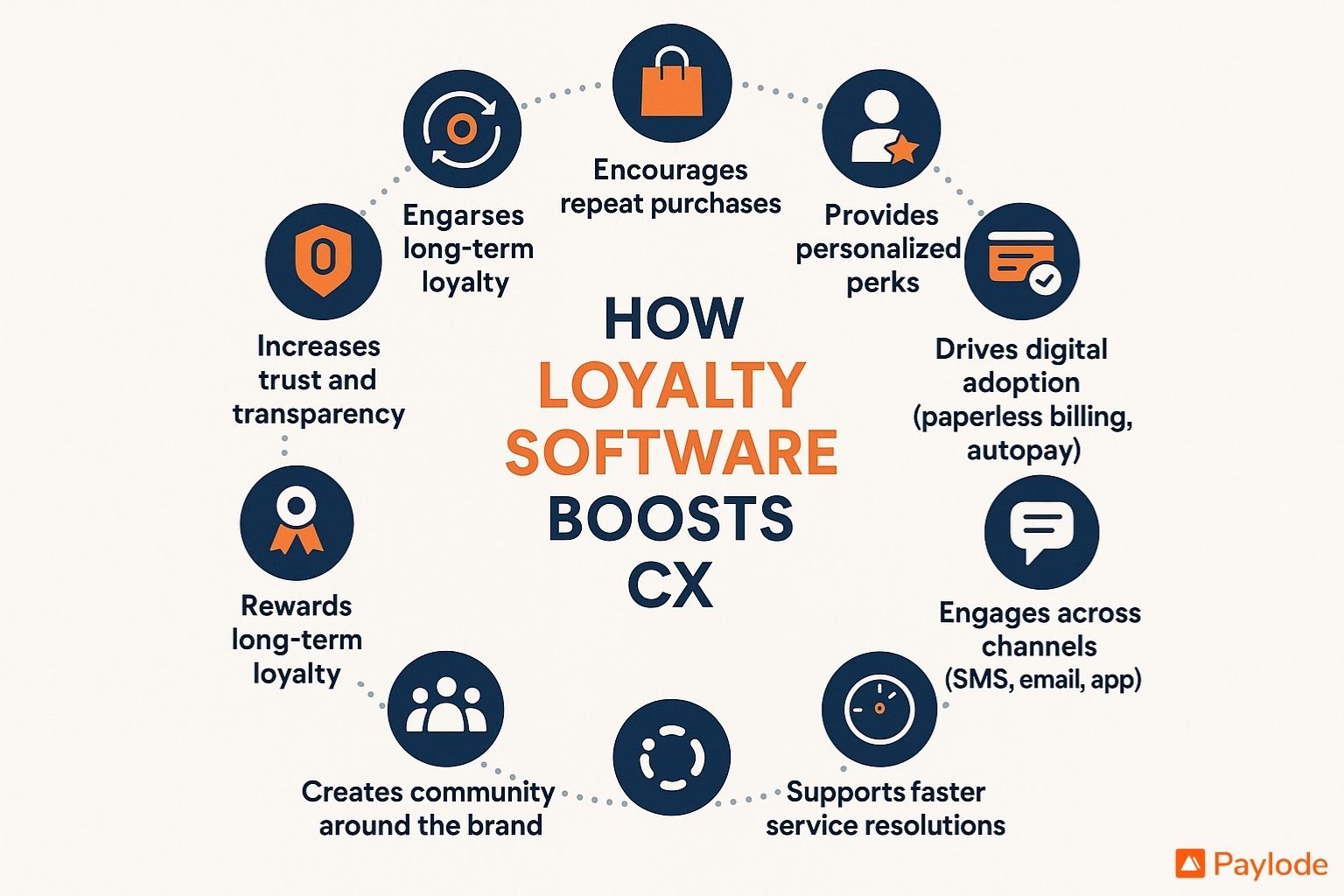
Customer Loyalty Software Case Studies: Real ROI Across Industries
The best way to understand the impact of customer loyalty software is by looking at real-world examples. Different industries face different retention challenges, yet loyalty platforms consistently prove their value by reducing churn, increasing engagement, and driving higher lifetime value (LTV). Below are case studies showing measurable ROI across sectors.
1. Telecom & ISP: Reducing Churn
Challenge: ISPs face high churn because customers often switch providers for minor price differences.
Solution: By using loyalty software, an ISP launched perks like free streaming bundles, bonus data on renewals, and paperless billing rewards.
Result: Churn dropped by 25–30%, with customers showing stronger adoption of digital tools like autopay and online portals.
2. Financial Services: Cross-Sell & Upsell Growth
Challenge: A retail bank wanted to deepen relationships with existing customers rather than focus only on new acquisition.
Solution: Loyalty software enabled personalized rewards—such as cashbacks for using a new credit card or bonus points for setting up savings accounts.
Result: The bank saw a 20–25% increase in revenue through cross-sell and upsell, while customer engagement with digital banking tools improved significantly.
3. Residential Real Estate: Boosting Tenant Retention
Challenge: Property managers struggled with lease renewals as tenants often moved for convenience or cost reasons.
Solution: A loyalty program offered residents perks like local retail discounts, wellness memberships, and referral bonuses for bringing in new tenants.
Result: Tenant retention improved by 15–20%, with higher satisfaction scores reported in community surveys.
4. Digital Health: Increasing Subscription Renewals
Challenge: A digital health app faced drop-offs after the first subscription cycle, hurting recurring revenue.
Solution: Loyalty software incentivized healthy behaviors—rewarding users for daily check-ins, completing wellness goals, and renewing subscriptions.
Result: Subscription renewals increased by 18–22%, directly boosting recurring revenue and customer LTV.
Key ROI Outcomes Across Industries
Why These Case Studies Matter
These examples highlight that customer loyalty software delivers measurable results across very different business models. Whether it’s reducing churn, driving upsells, or building long-term relationships, the ROI is clear: loyalty platforms make retention a growth strategy rather than just a defensive move.
Conclusion: Why Customer Loyalty Software is the Future of Retention
Customer acquisition costs are rising across every industry, making retention more valuable than ever. Traditional rewards programs alone are no longer enough. Modern customer loyalty software goes beyond discounts and points—it builds stronger relationships through personalization, automation, and real-time insights.
From telecom providers reducing churn to digital health apps boosting subscription renewals, the ROI of loyalty software is clear. Businesses that invest in retention strategies see not only happier customers but also higher lifetime value, stronger brand advocacy, and more predictable recurring revenue.
The future of retention lies in platforms that make loyalty effortless—integrating seamlessly with billing, CRM, and mobile apps while offering flexible perks that resonate with customers’ daily lives. By prioritizing loyalty, companies transform one-time buyers into long-term partners.
If your business wants to stay competitive in 2025 and beyond, now is the time to act.
Start exploring Paylode’s customer loyalty software and discover how you can reduce churn, improve digital adoption, and increase revenue through smarter retention strategies.
